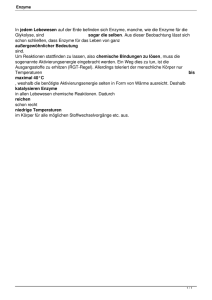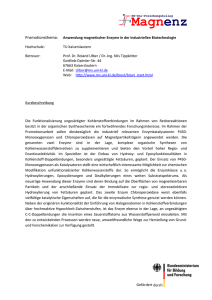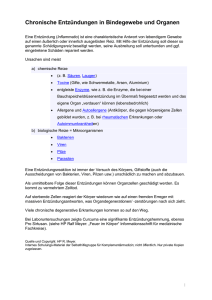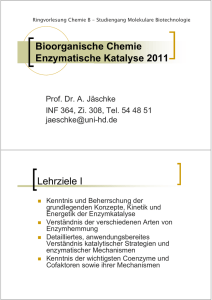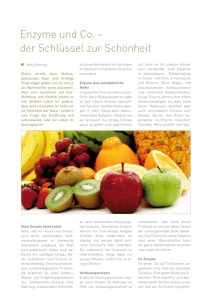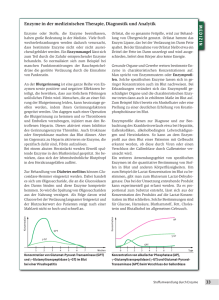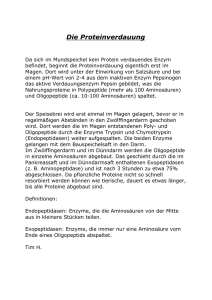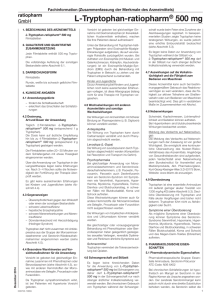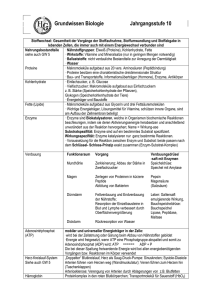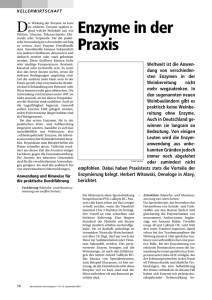i2,w.uii m - ETH E
Werbung
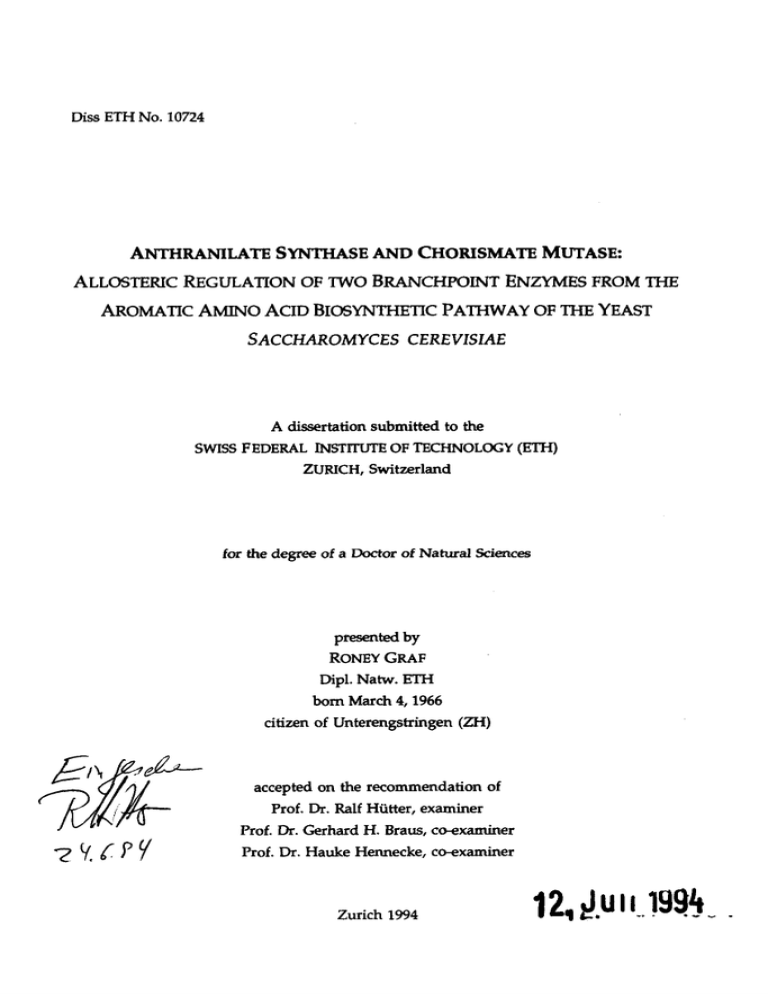
Diss ETH No. 10724 ANTHRANILATE SYNTHASE AND CHORISMATE MUTASE: ALLOSTERIC REGULATION OF TWO BRANCHPOINT ENZYMES FROM THE AROMATIC AMINO ACID BlOSYNTHETIC PATHWAY OF THE YEAST SACCHAROMYCES CEREVISIAE A dissertation submitted to the SWISS FEDERAL INSTITUTE OF TECHNOLOGY (ETH) ZURICH, Switzerland for the degree of a Doctor of Natural Sciences presented by roney Graf Dipl. Narw. ETH born March 4,1966 citizen of accepted Unterengstringen (ZH) on the recommendation of Prof. Dr. Ralf Hurler, examiner Prof. Dr. Gerhard H. Braus, co-examiner Prof. Dr. Hauke Hennecke, co-examiner Zurich 1994 i2,w.uii m 1 SUMMARY The regulation of two enzymes aromatic amino acid was Anthranilate investigated. (E.C. 5.4.99.5), both for competing biosynthetic pathway in the synthase (E.C. 4.1.3.27) using pathway Anthranilate branch, is formed and the gene by mutant allele of TRP2 encodes TRP2fl>r allele revealed the end another conserved element, not was leading Serine 76 analysis of the enzyme as found to be far. Its so a Chorismate mutase, the first reaction of the subject proximity an extended activated enzyme kinetic behaviour tryptophan- of carrying same was Therefore, it functional element. of the AR07 gene, is responsible for the branch. The homodimeric by tyrosine and to 'cross-branch'- a Its kinetic behaviour conforms the classical Monod- was the in residue 226 and point observations: a) None of the mutation leading to a causing a constitutively found to be frozen in the active allosteric R-state. resulting nine steady-state constant of the enzyme, exchange reduction of feedback both mutations. mutations in codon 226 of the AR07 gene determination of their kinetic exchanges enzymes parameters by decreasing Km, along tyrosine and with decreasing cooperativity a was was created, and the analysed. led to the to a decreasing of substrate specific The following at residue 226 affected the b) All mutations led enzyme a part product exchange (AR07c) new equivalent model for allosteric enzymes. A threonine-to-isoleucine A set of an of the feedback inhibition by tryptophan. Wyman-Changeux led to construct are to another serine known to be involved in tyrosine/phenylalanine-specific to highly the TRP2ft* mutation in serine 76, and this effect a a of this to a serine-to-leucine was the presence of arginine concluded that both serines activation mutation wildtype pathway, tryptophan, element with the sequence LLESSS-Xio-S7*. The site-directed found to be enhanced in enzyme is of the synthases analysed comprising of the upstream serine 65 to sensitivity product protein. tryptophan regulation, suggested regulatory step of the tryptophan-specific feedback-resistant enzyme. The conserved residue in all anthranilate or branchpoint important targets for regulation. the first single point 76 of the position at a a tryptophan form the central of TRP2 and TRP3. Whereas the products enzyme is feedback inhibited exchange therefore are synthase, catalysing by and chorismate mutase chorismic acid for the first steps of tyrosine/phenylalanine biosynthesis, respectively, in this metabolic substrate in the a common yeast Saccharomyces cerevisiae catalytic activation of the response to the inhibitor binding, c) The strength of the 2 deregulation did not correlate with any characteristic of the amino acid at allosteric position 226. The data T-R-equilibrium mutations. This model studies of tyrosine Closely end of an proteins was carrier was tested and confirmed tryptophan reading sequenced, and indicated that the protein and was indeed YMCl. a a encoding new a transcript disruption it was - of the the various ligand binding superfamily of membrane shown, the entire gene mutant was constructed. therefore named YMCl. A particular, in vitro by chorismate mutase, the 3'- was gene encodes associated with the AR07 locus triggered by gradual shifting a by introduced enzymes. frame with similarities to mutant could not be detected. In phenotype to the mutant detected. The presence of cloned and comparisons consistent with of the enzyme towards the R-state downstream of the AR07 gene open was and are artificially a Sequence putative mitochondrial phenotype for the disruption shown that the osmosensitive although unexplainable inactivation of the AR07 gene and not by its so far - is neighbour 3 ZUSAMMENFASSUNG Gegenstand dieser Untersuchungen welche in der aromatischen war die gemeinsame Anthranilatsynthase (E.C. 4.1.3.27) Substrat jeweils den Schritt cerevisiae um das beziehungsweise Tyrosin zentralen Astes und wird WShrend das gebildet. der diesem in Saccharomyces konkurrieren. (E.C. 5.4.99.5), die Synthese Tryptophan von befinden sich und Biosyntheseweg sind am daher Regulation. Anthranilatsynthase katalysiert spezifischen Chorisminsaure Phenylalanin katalysieren, und Verzweigungspunkt Punkte in dessen wichtige der beiden Enzyme, in der Hefe und Chorismarmutase spezifischen ersten Regulation Aminosaurebiosynthese Enzym den ersten Schritt Tryptophan- des den Produkten der Gene TRP2 und TRP3 von Wildtypform in der durch Tryptophan gehemmt wird, zeigt das Produkt des Mutantenallels TRP2fl» (furfeedback-resistant) keine Endprodukthemmung. Im TRP2fl>r-Gen konnte eine einzelne Punktmutation identifiziert werden, die einen Austausch eines Serins Leucin bewirkt. Dieses Serin 76 ist in alien bekannten weitgehend konserviert, und da konservierten und in der Regulation es an Anthranilatsynthasen in der Nahe eines durch Position 76 gegen anderen, ebenfalls involvierten Bereiches Tryptophan liegt, wurde ein erweitertes regulatorisches Element mit der Sequenz LLES65-XioS76 postuliert. Ein gezielter Austausch von Serin 76 bewirkte eine gleichwertige Verminderung der Regulierbarkeit des Enzyms durch Tryptophan wie die gleichzeitigen TRPZ/^-Mutation in Serin 65, und dieser Effekt konnte durch den Austausch beider geschlossen, Serinpositionen Tryptophan-regulatorischen Katalyse andererseits durch dem aus zwei Einheiten des der ersten Reaktion des Astes verantwortlich. Das Enzym Tryptophan Isoleucin Enzym wurde an durchgefuhrt, Tyrosin gehemmt, aktiviert. Ihr kinetisches Verhalten lasst sich mit fiir allosteriche Enzyme beschreiben. die einen Austausch eines Threonins gegen (AR07c), Position 226 bewirkt und sich in einem konstitutiv aktivierten aussert, friert das eine AR07-Genproduktes, Tyrosin-/Phenylalanin-spezifischen wird einerseits durch Monod-Wyman-Changeux-Modell Eine Punktmutation einzigen Elementes sind. Chorismarmutase, bestehend ist fur die nicht mehr verstarkt werden. Daraus wurde dass sowohl Serin 65 als auch Serin 76 Teile eines Serie Enzym weiterer im aktiven allosterischen R-Zustand ein. Daher Aminosaure-Austausche an und die kinetischen Daten der resultierenden der neun Stelle 226 Enzymspezies 4 bestimmt. Dabei wurden hatte Mutationen Chorismatmutase. durch Senkung und der Ergebnisse und so hin von keiner des Die an der der Enzyms Tyrosin Starke des spezifischen Eigenschaft Aminosaure bewirken. Tyrosin und T-R-Gleichgewichts Dieses Modell Tryptophan Position 226. der Diese an in unterschiedlicher wurde die durch mutierten in vitro Enzyme bestatigt. AR07-Gens, welches fur Chorismatmutase kodiert, wurde ein offener Leseraster entdeckt, der Membranproteinen daraufhin Aktivierung Substratbindung. c) eingefiihrten Nahe des 3'-Endes des von Keine Konstante erklaren, dass die verschiedenen Mutationen jeweils des allosterischen R-Seite Bindungsstudien der korrelierte mit kunstlich lassen sich zur katalytische Alle Mutationen bewirkten eine Effektes Verschiebung uberpruft b) die auf des Km, sowie eine Abnahme der Hemmbarkeit durch entsprechenden Starke Einfluss Kooperativitat bezuglich beobachteten eine folgende Beobachtungen gemacht: a) einen aufweist. Ein Homologien zu einer Superfamilie entsprechendes Transkript konnte nachgewiesen werden, das vollstandige Gen wurde kloniert und sequenziert und eine Sequenzvergleichen mitochondriales Mutante wurde durch geschlossen, Transportprotein Gen-Disruption konstruiert. Aus dass dieses Gen vermutlich fiir ein kodiert. Es erhielt daher die Bezeichnung YMCl, fur yeast mitochondrial carrier. Ein besonderer Phanotyp der Mutante konnte nicht beobachtet werden. Insbesondere wurde nachgewiesen, dass die noch unerklarte Osmosensitivitat, welche mit Mutationen im Bereich des AR07Locus einhergeht, tatsachlich mit dem AR07-Gen selbst und nicht mit dem benachbarten YMCl-Gen assoziiert ist.
